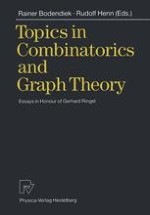1990 | OriginalPaper | Chapter
Non-Commutative Geometry and Graphs
Author : J. André
Published in: Topics in Combinatorics and Graph Theory
Publisher: Physica-Verlag HD
Included in: Professional Book Archive
Activate our intelligent search to find suitable subject content or patents.
Select sections of text to find matching patents with Artificial Intelligence. powered by
Select sections of text to find additional relevant content using AI-assisted search. powered by
Objects of this paper are complete digraphs (directed simple graphs). A colouring of such a digraph is a mapping from the vertices and the arcs onto a set F of colours. We assume that vertices and arcs are differently coloured but do provisionally no further restrictions. Following J. Pfalzgraf [8] we denote this mapping by <,>. Thus <x,x’> is the colour of the arc (x,x’) if x ≠ x’ and of the vertex x if x = x’. Such a coloured complete digraph is also called a P-space. We interpret the vertices and colours as proper and improper points resp. and define the line (Linie) x□x’ by (2.1), (2.2). Generally x□x’ ≠ x’□x, i.e. the space need not be commutative. A simple example of such a (noncommutative) space is the circle-space: Here X :=R2 and the line xqx’ is the circle through x’ with the center x, and its improper point is its radius. Two lines with the same improper point are parallel. Two different parallel lines, however, need not have an empty intersection. The first two sections give a brief introduction to the P-spaces, for more details (with further references) see [2]. Subspaces are point sets being closed with respect to drawing of lines and parallels. A straight line (Gerade) is a line which is also a subspace (sect.3). Arbitrary P-spaces are too general for establishing a reasonable theory. Therefore we additionally assume geometrical conditions which are generalizations of the well known Desargues theorem in affine spaces: We define a sequence Simq (q∈N)of geometrical conditions. The simplest non trivial case q = 2 leads to the skewaffine spaces. A skewaffine space with commutative □ is affine. An application of the theory of Ramsey-numbers leads to a theorem that a finite selfadjoint skewaffine space in which the number of proper points is large to that of improper points possesses a staight line (Theorem 6.1). The following Theorem 6.2 specializes this property to permutation groups. In the two concluding sections we consider finite P-spaces and their connections to adjaceny-matrizes and hence to algebraic graph theory. A geometric characterization of distance regular graphs is stated in Theorem 8.2. It might be fruitful to enlarge this theory in order to obtain further relations between graph theory and geometry.
